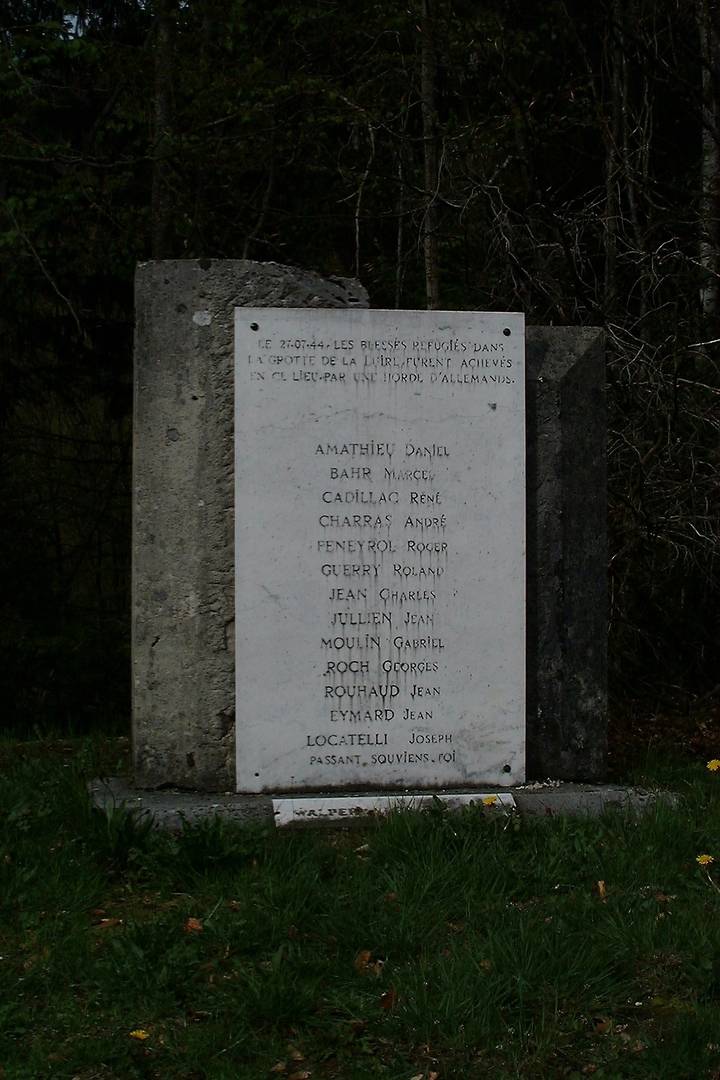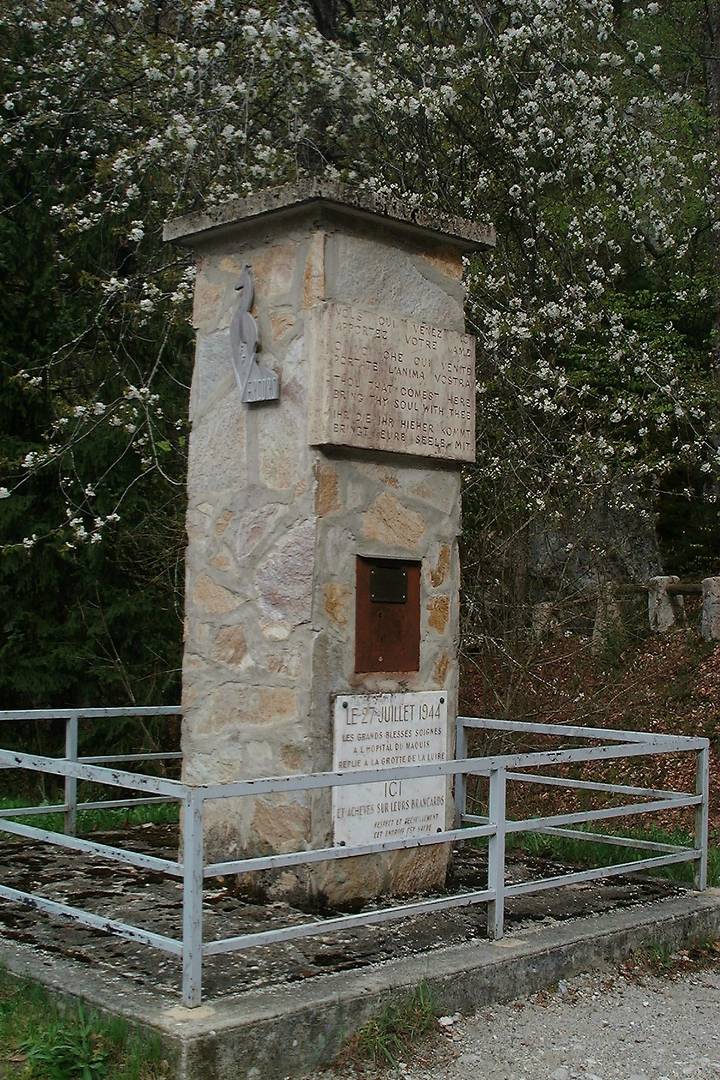Voir les témoignages à propos de ce site
et donner le votre
Memospace site de partage de lieux historiques
Saint-Agnan-en-Vercors
Grotte de la Luire
In the night of July 21-22, 1944, in light of the German invasion of southern Vercors, François Huet's HQ ordered the sick and wounded of the maquis hospitals at Saint-Martin-en-Vercors and Tourtre to fall back toward Die. Drs Ganimède, Fischer (Ferrier), Ullmann, Beunier-Blum and Wolf accompanied the first convoy, of 122 wounded, ill and care-givers. The chief doctor of Vercors, Fernand Ganimède, decided, with the approval of HQ, to withdraw into the Luire cave, which Dr Fischer had found the day before, because of the German advance in the Drome valley.
On July 22, during the day and night, the other... Read more
Coordinates
- Monument
- Commemorative plaque
- Maquis
- Civil resistance
- Deportation
- Repression
- Drome
- Historic site
- Armed Resistance
In the night of July 21-22, 1944, in light of the German invasion of southern Vercors, François Huet's HQ ordered the sick and wounded of the maquis hospitals at Saint-Martin-en-Vercors and Tourtre to fall back toward Die. Drs Ganimède, Fischer (Ferrier), Ullmann, Beunier-Blum and Wolf accompanied the first convoy, of 122 wounded, ill and care-givers. The chief doctor of Vercors, Fernand Ganimède, decided, with the approval of HQ, to withdraw into the Luire cave, which Dr Fischer had found the day before, because of the German advance in the Drome valley.
On July 22, during the day and night, the other wounded were taken by bus from Saint-Martin to the cave by Fabien Rey, who decided that only fighters who could not be moved and the strictly necessary medical staff would stay there. In the evening of the 22nd, a group of fifty wounded, doctors (Beunier-Blum and Wolf) and nurses left the cave in two groups, before the Germans arrived. One group, after crossing the ridge from East to West, finally got to Romans, guided by Mr Trial and his son. Four other wounded had previously made it to another cave on the other side of the valley, above les Chaberts.
So about fifty people were still in the cave: 28 maquis, two women from Vassieux, an American officer, Chester Meyers, parachuted in with a commando squad on June 29, Ganimède's wife and seventeen-year-old son, four wounded German and Polish soldiers, captured during the fighting at Montclus on June 19 and 22, Félix Dombrowski, Kruzel, Malacowski, Veroneck; three doctors (Ganimède, Fischer, Ullmann); seven nurses (Rosine Bernheim, Cécile Golden, Odette Malossane (Betty), France Pinhas, Suzette Siveton, Anita Winter, Maud Romana); a first-aid nurse from the Red Cross, and a Jesuit, Father Yves Moreau de Montcheuil (a philosopher and theologian who had participated in the writing and publishing of Cahiers du Témoignage Chrétien, against anti-semitism.)
A white sheet with a red cross was hung up at the mouth of the cave, and the army convoys could be heard on the road some 400 meters away. Some of the wounded succombed to their injuries before the Germans arrived on July 27.
On July 27 at 4pm, the Germans reached the cave. The commander rebuked the captive soldiersw who had asked him not to fire on the people present as they had cared for them, and demanded in French to see the person in charge of the camp. The doctors introduced themselves, and were lined up against a wall with the nurses. The wounded were stood up, their bandages ripped off, and their belongings taken away. Three attempted to flee, but were caught and shot near the cave. Two groups were formed.
A farmer, Jarrand, was requisitioned with his wagon to take the severely wounded to Rousset. On the way, they met a group of German paratroopers who told them to go back to the Luire cave, and executed them below.
Another group went off toward Rousset as well. Abdesselem Ben Ahmed insulted the Austrian commander, calling him a dirty Kraut; the commander halted the group, knocked him down with the butt of a submachine gun and hanged him. On July 28, at the Oules bridge (upstream from Rousset), seven wounded were killed after digging their own graves. The others were taken to Grenoble and imprisoned at the Bonnes garrison, Gestapo headquarters. The captured soldiers helped the civilians to escape; Dr Ganimède also managed to get away while at the toilet. In the night of August 11-11, 1944, Drs Fisher and Ullman and Father Yves Moreau de Montcheuil were shot. The American officer was spared. Though wearing a French army uniform, Francis Billon was also shot. The nurses were deported. Odette Malossane never returned.
On July 27, 1946, a commemoration was held in the Luire cave with representatives of the State, local elected authorities and the population including a number of former fighters.
There are now five plaques on the walls inside the cave, put up by the Vercors Pioneers, Veterans of the the 11th Heavy Cavalry, the Young Socialists of Drome, and French Memory. There are also two stone markers to been seen below the cave.
Sources : Musée de la résistance en ligne, fiches "Blessés et soignants de l'hôpital de la grotte de la Luire", "La grotte de la Luire" et "Plaques commémoratives dans la grotte de la Luire"

